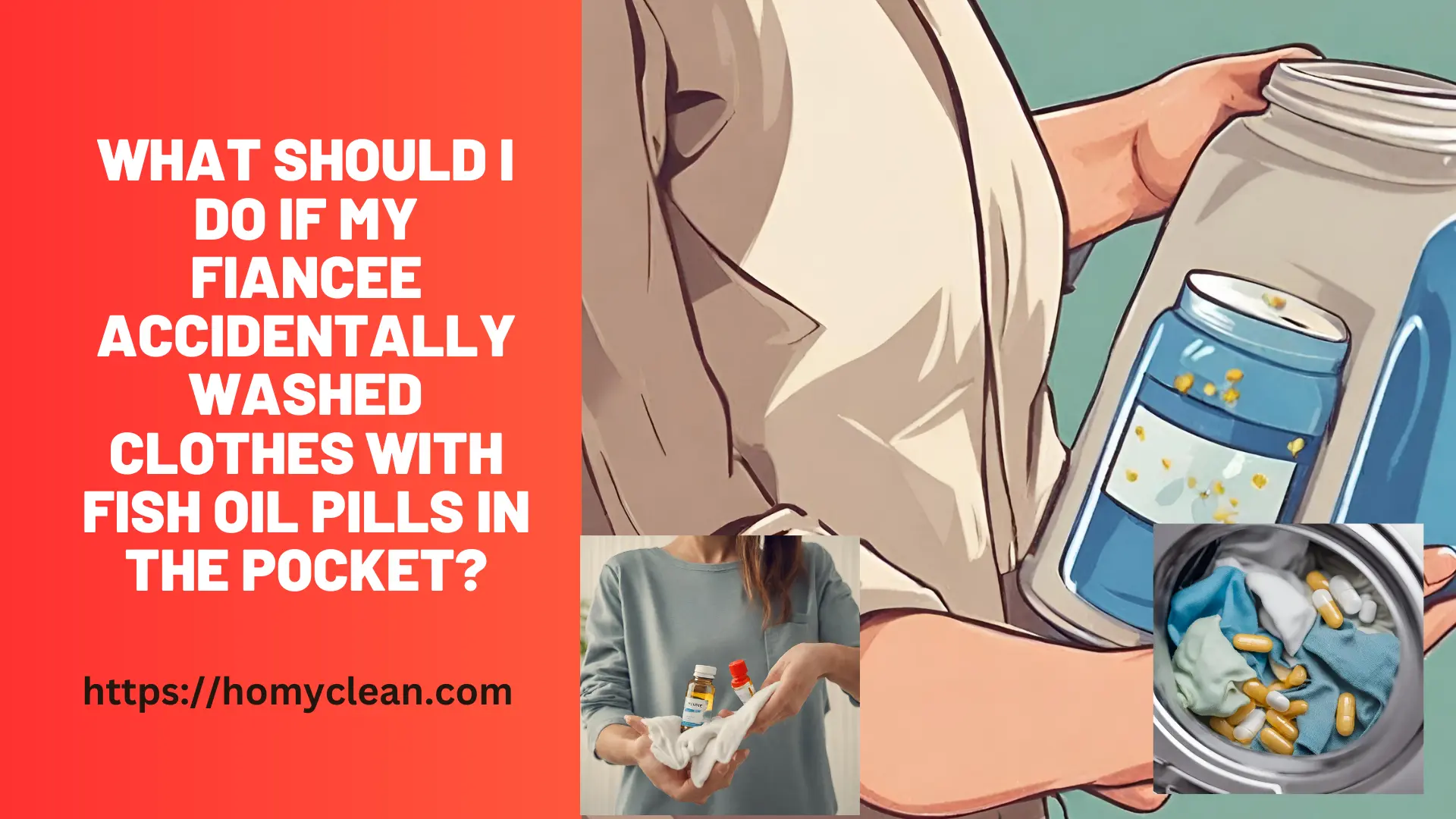You’re eagerly unloading the washing machine, only to discover an unpleasant surprise. Your fiancée accidentally washed clothes with fish oil pills in the pocket. Before panic sets in, take a deep breath. In this guide, we’ll delve into the unexpected world of laundry mishaps and explore practical solutions to salvage your clothes from the slippery aftermath. So, let’s dive into the soapy saga of fish oil, laundry, and the art of turning a wardrobe mishap into a triumph.”
From the kitchen to the laundry room, fish oil pills seem to have a knack for finding their way into unexpected places. Whether it’s a forgotten pocket or a laundry basket oversight, dealing with the aftermath requires a strategic approach. Picture this: you open the washing machine, and there they are – those elusive fish oil pills, now dispersed among your clothes. Before frustration takes over, let’s break down the steps to rescue your garments and navigate this slippery situation.
What Should I If Washed Clothes with Fish oil pill stain removal methods
Step 1: Assess the Damage
Begin by carefully examining the affected clothes. Identify any visible fish oil stains or residue. Take note of the fabrics involved, as different materials may require specific treatment methods. This initial assessment sets the stage for a targeted and effective cleaning process.
Real-Life Example:
A Reddit user, u/LaundryDisasterSurvivor, shared their experience with a fish oil pill mishap. “I couldn’t believe it when I opened the washer. My favorite shirt was covered in fishy stains. But, with a bit of research and quick action, I managed to salvage it. Here’s what I did…”
Step 2: Immediate Action
Time is of the essence when dealing with fish oil stains. Act quickly to prevent the oil from setting into the fabric. Begin by blotting the affected areas with paper towels or a clean cloth to absorb excess oil. Avoid rubbing, as it can spread the stain. Once you’ve removed as much surface oil as possible, it’s time to address the residue within the fabric fibers.
Step 3: Pre-Treatment and Washing
To combat the stubborn fish oil residue, pre-treat the stained areas with a suitable stain remover or dish soap. Gently rub the pre-treatment into the fabric and let it sit for at least 15 minutes. This helps break down the oil before the main wash. When it comes to selecting a detergent, opt for one with strong stain-fighting capabilities.
Step 4: Washing Machine Magic
Once you’ve pre-treated the stains, it’s time for the main event – the washing machine. Use the hottest water suitable for the fabric and add an extra rinse cycle to ensure all traces of fish oil and cleaning agents are thoroughly removed.
Real-Life Example:
Sarah, a busy mom of two, shared her laundry adventure on a parenting forum. “Fish oil capsules went through the wash with my son’s school uniform. I was worried, but after following these steps, you’d never know it happened!”
Step 5: Drying with Caution
Once the washing machine has worked its magic, resist the temptation to throw your clothes into the dryer immediately. Heat can set any remaining fish oil stains, making them more challenging to remove. Instead, opt for air-drying your garments. Lay them flat on a clean, dry towel or hang them up to ensure proper ventilation. This gentle drying approach allows any residual stains to dissipate.
People Also Visit:
- How Can I Remove Sticky Purple Residue From Shorts After Washing
- Why My Washing Machine Has Scrub
- How Can I Wash Muddy Trainers With Muddy Clothes In Washing Machine
Real-Life Example:
Dave, an avid fisherman, found himself in a sticky situation after a fishing trip. “My lucky fishing hat ended up in the wash with fish oil capsules. Following advice online, I air-dried it, and the stains vanished. My fishing adventures continue with an unblemished hat!”
Step 6: Special Fabric Considerations
Different fabrics demand different care. Delicate fabrics such as silk or wool require a gentler touch. Consider using a mild detergent and handwashing these items to preserve their integrity. Always check the care label on your clothes for specific instructions.
Navigating the fish oil pill debacle becomes more nuanced when delicate fabrics are involved. Let’s explore the intricacies of handling silk, wool, and other unique materials.
Real-Life Example:
Jennifer, a fashion enthusiast, faced a fish oil mishap with her silk blouse. “I was devastated, but a friend suggested handwashing with a gentle detergent. It worked like a charm, and my blouse was as good as new.”
Step 7: Prevention for the Future
Now that you’ve successfully rescued your clothes from the clutches of fish oil, it’s time to think about preventing a repeat performance. Make it a habit to check pockets thoroughly before tossing clothes into the laundry. Consider using laundry bags for items with easily forgotten pockets, minimizing the risk of future surprises.
Real-Life Example:
Mark, a dad with a penchant for multitasking, learned the importance of pocket checks the hard way. “After a fish oil capsule incident, I’ve made it a family rule – pockets get a pre-laundry check. No more unexpected surprises!”
Step 8: Odor Elimination Techniques
Fish oil doesn’t just leave stains; it can also leave behind a lingering, unpleasant odor. To tackle this olfactory challenge, add a cup of white vinegar or baking soda to the wash during the rinse cycle. These natural deodorizers work wonders in neutralizing fishy smells, leaving your clothes fresh and odor-free.
Real-Life Example:
Tina, a fitness enthusiast, shared her experience with fish oil-scented workout gear. “I thought I’d have to say goodbye to my favorite gym clothes, but a vinegar rinse did the trick. No more fishy gym sessions!”
Step 9: Seeking Professional Help
In cases where fish oil stains prove particularly stubborn or your clothing requires special care, don’t hesitate to seek professional assistance. Professional dry cleaners are equipped with the expertise and specialized solvents needed to tackle challenging stains effectively.
Step 10: Severity Matters – Adjusting Your Approach
The severity of the fish oil pill mishap can vary, and so should your cleaning approach. For minor stains, the steps mentioned earlier should suffice. However, if the stains are extensive or deeply set, a more intensive cleaning regimen may be required.
Understanding the extent of the stain is crucial in determining the appropriate course of action. Let’s delve into the nuances of assessing stain severity.
Real-Life Example:
Mike, a DIY enthusiast, faced a challenging situation when his entire load of laundry was affected. “It was a mess. The whole load smelled like fish, but with a combination of vinegar, extra detergent, and patience, I managed to salvage most of it.”
Step 11: The Power of Patience
When dealing with fish oil stains, patience is indeed a virtue. Rushing the cleaning process can lead to incomplete stain removal or set the stains further into the fabric. Allow each step, from pre-treatment to drying, the time it needs to work effectively.
Step 12: Post-Cleaning Inspection
After your clothes have been through the cleaning journey, conduct a thorough inspection in natural light. This step ensures you haven’t missed any residual stains and gives you the confidence that your garments are truly fish oil-free.
Real-Life Example:
Emma, a college student, learned the value of patience the hard way. “I was in a rush and didn’t let the stain remover sit long enough. It took a second round and a bit of patience, but my jeans were saved!
Conclusion
In the unpredictable world of laundry, accidents happen. When fish oil pills join the wash, it’s a challenge that requires a cool head and a strategic approach. By following these steps and learning from real-life experiences, you can turn a laundry disaster into a triumph. So, the next time your fiancée accidentally washes clothes with fish oil pills in the pocket, you’ll be armed with the knowledge to tackle the situation with confidence.





